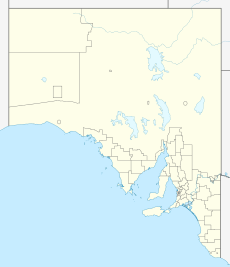Cap Island Conservation Park facts for kids
Quick facts for kids Cap Island Conservation ParkSouth Australia |
|
|---|---|
|
IUCN Category Ia (Strict Nature Reserve)
|
|
| Nearest town or city | Elliston. |
| Established | 16 March 1967 |
| Area | 9 hectares (22 acres) |
| Managing authorities | Department for Environment and Water |
| See also | Protected areas of South Australia |
Cap Island Conservation Park is a special place in South Australia. It's a protected area, meaning it's kept safe for nature. This park is on Cap Island, which is about 7.5 kilometers (4.6 miles) off the coast of the Eyre Peninsula. The island itself is quite small, covering about 8 hectares (20 acres).
Cap Island has a rocky base made of granite. Its edges are steep and worn away by the ocean. You'll mostly find a type of plant called Nitre Bush growing there. This park was created in 1972 to protect important areas. It's a safe home for many seabirds to lay their eggs. It's also a resting spot for amazing animals like the Australian sea lion and the New Zealand Fur-seal.
Sometimes, Cap Island is also called Gap Island. Long ago, people even knew it as Rocky Island.
History of Cap Island
The famous explorer Matthew Flinders named Cap Island on February 16, 1802. He chose the name because of the island's shape. It looked a bit like a cap or hat from a distance.
In 1967, the island was first declared a Fauna Conservation Reserve. This meant it was a special place to protect animals. Later, in 1972, it officially became the Cap Island Conservation Park. This park is listed as an IUCN Category Ia protected area. This is the highest level of protection. It means the area is kept as wild and untouched as possible. This is done to protect its unique nature.
Animals of Cap Island
Cap Island is home to many different animals. Besides the marine mammals, at least nine types of birds have been seen here. These birds use the island as a safe place to live and raise their young.
Some of the birds you might find include:
- Chroicocephalus novaehollandiae: The Silver Gull
- Haematopus fuliginosus fuliginosus: The Sooty Oystercatcher
- Hirundo (Hirundo) neoxena neoxena: The Welcome Swallow
- Neophema (Neonanodes) petrophila: The Rock Parrot
- Pelagodroma marina: The White-faced Storm-petrel
- Sterna (Sterna) striata: The White-fronted Tern
- Sternula nereis nereis: The Fairy Tern
- Sturnus (Sturnus) vulgaris vulgaris: The Common Starling
- Thalasseus bergii: The Crested Tern
Plants of Cap Island
The island also has a variety of plants that can survive its tough conditions. At least eight different plant species have been recorded on Cap Island. These plants are important for the island's ecosystem. They provide food and shelter for the animals.
Some of the plants found here are:
- Apium prostratum var. prostratum: Sea Celery
- Disphyma crassifolium subsp. clavellatum: Rounded Noon-flower
- Frankenia pauciflora var. fruticulosa
- Frankenia pauciflora: Australian Sea-heath
- Lawrencia squamata: Thorny Lawrencia
- Mesembryanthemum crystallinum: Common Ice plant
- Nitraria billardierei: Dillon Bush
- Zygophyllum apiculatum: Callweed


